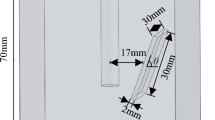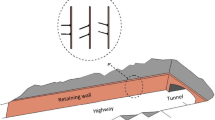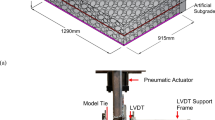Abstract
In this work, toppling failure of a jointed rock slope is studied by using the distinct lattice spring model (DLSM). The gravity increase method (GIM) with a sub-step loading scheme is implemented in the DLSM to mimic the loading conditions of a centrifuge test. A classical centrifuge test for a jointed rock slope, previously simulated by the finite element method and the discrete element model, is simulated by using the GIM-DLSM. Reasonable boundary conditions are obtained through detailed comparisons among existing numerical solutions with experimental records. With calibrated boundary conditions, the influences of the tensional strength of the rock block, cohesion and friction angles of the joints, as well as the spacing and inclination angles of the joints, on the flexural toppling failure of the jointed rock slope are investigated by using the GIM-DLSM, leading to some insight into evaluating the state of flexural toppling failure for a jointed slope and effectively preventing the flexural toppling failure of jointed rock slopes.




















Similar content being viewed by others
Abbreviations
- A D :
-
The representative area of a discontinuous spring bond
- [C]:
-
The damping matrix
- c D :
-
The cohesion of a discontinuous bond
- c J :
-
The corresponding macroscopic joint parameters
- E :
-
The Young’s modulus
- E i :
-
The Young’s modulus of particle i
- E j :
-
The Young’s modulus of particle j
- \(\sum {{\mathbf{F}}_{j}^{(t)} }\) :
-
The total force applied to the particle
- f n :
-
The normal spring force
- F(t):
-
The external force vector
- f D t :
-
The tensional strength
- g_level :
-
The current gravity level
- g_max :
-
The maximum gravity level for the simulation
- g(t):
-
The gravity increase function
- inter_Loop :
-
The number of iterations for the sub-calculation
- Loop :
-
The index of the current iteration
- [K]:
-
The stiffness matrix
- k n :
-
The normal spring stiffness
- k D n :
-
The normal spring stiffness of a discontinuous bond
- k J n :
-
The macroscopic joint normal stiffness
- k s :
-
The shear spring stiffness
- k D s :
-
The shear spring stiffness of a discontinuous bond
- k J s :
-
The macroscopic joint shear stiffness
- [M]:
-
The mass matrix
- diag([M]):
-
The diagonal elements of the mass matrix
- max_Loop :
-
The maximum loop for the simulation
- m p :
-
The mass of a particle
- n TC :
-
The total number of spring bonds cut by the same triangle
- S T :
-
The area of the triangle
- ∆t :
-
The time step
- u :
-
The vector of particle displacement
- u n D :
-
The discontinuous spring’s normal deformation vector
- u s D :
-
The discontinuous spring’s shear deformation vector
- u n :
-
The spring’s normal deformation
- \({\dot{\mathbf{u}}}_{i}^{(t + \Delta t/2)}\) :
-
The particle velocity at t + ∆t/2
- \({\dot{\mathbf{u}}}_{i}^{(t - \Delta t/2)}\) :
-
The particle velocity at t − ∆t/2
- u (t+Δt) i :
-
The displacement at t + ∆t
- u (t) i :
-
The displacement at t
- u * t :
-
The ultimate tensional deformation of the spring
- ν:
-
The Poisson’s ratio
- ν i :
-
The Poisson’s ratio at particle i
- ν j :
-
The Poisson’s ratio at particle j
- V :
-
The volume of the geometry model
- α3D :
-
The lattice coefficient of a computational model
- ϕ D :
-
The internal friction angle of the discontinuous spring bond
- ϕ J t :
-
The macroscopic joint friction angle
References
Adhikary DP, Guo H (2002) An orthotropic Cosseratelasto-plastic model for layered rocks. Rock Mech Rock Eng 35(3):161–170
Adhikary DP, Dyskin AV, Jewell RJ, Stewart DP (1997) A study of the mechanism of flexural toppling failure of rock slopes. Rock Mech Rock Eng 30(2):75–93
Alzoubi AK, Martin CD, Cruden DM (2010) Influence of tensile strength on toppling failure in centrifuge tests. Int J Rock Mech Min Sci 47:974–982
Aydan O, Kawamoto T (1992) Stability of slopes and underground openings against flexural toppling and their stabilisation. Rock Mech Rock Eng 25(3):143–165
Chen ZY, Gong WJ, Guowei MA, Wang J, Lei HE, Xing YC, Xing JY (2015) Comparisons between centrifuge and numerical modeling results for slope toppling failure. Sci China Technol Sci 58(9):1497–1508
Cundall PA (1971) A computer model for simulating progressive large scale movements in blocky rock systems. In: Proceedings of the international symposium on rock fracture, Nancy, October 1971. International Society for Rock Mechanics (ISRM), 1, paper no. II–8, pp 129–136
Goodman RE, Bray JW (1976) Topping of rock slopes. ASCE speciality conference on rock engineering for foundations and slopes, Boulder Colorado, vol 2, pp 201–234
Kazerani T, Zhao GF, Zhao J (2010) Dynamic fracturing simulation of brittle material using the distinct lattice spring method with a full rate-dependent cohesive law. Rock Mech Rock Eng 43(6):717–726
Li LC, Tang CA, Zhu WC, Liang ZZ (2009) Numerical analysis of slope stability based on the gravity increase method. Comput Geotech 36:1246–1258
Shi GH, Goodman RE (1985) Two dimensional discontinuous deformation analysis. Int J Numer Anal Meth Geomech 9(6):541–556
Swan CC, Seo Y (1999) Limit state analysis of earthen slopes using dual continuum/FEM approaches. Int J Numer Anal Methods Geomech 23(12):1359–1371
Zhang JH, Chen ZY, Wang XG (2007) Centrifuge modeling of rock slopes susceptible to block toppling. Rock Mech Rock Eng 40(4):363–382
Zhang GX, Zhao Y, Peng XC (2010) Simulation of toppling failure of rock slope by numerical manifold method. Int J Comput Methods 7(01):167–189
Zhao GF (2015) Further development of distinct lattice spring model for jointed rock masses. Int J Rock Mech Min Sci 78:79–90
Zhao GF (2017) Developing a four-dimensional lattice spring model for mechanical responses of solids. Comput Meth Appl Mech Eng 315:881–895
Zhao GF, Fang J, Zhao J (2011) A 3D distinct lattice spring model for elasticity and dynamic failure. Int J Numer Anal Methods Geomech 35:859–885
Zhao GF, Fang J, Sun L, Zhao J (2013) Parallelization of the distinct lattice spring model. Int J Numer Anal Methods Geomech 37(1):51–74
Zhao GF, Russell AR, Zhao X, Khalili N (2014a) Strain rate dependency of uniaxial tensile strength in gosford sandstone by the distinct lattice spring model with x-ray micro CT. Int J Solids Struct 51(7–8):1587–1600
Zhao Y, Zhao GF, Jiang Y, Elsworth D, Huang Y (2014b) Effects of bedding on the dynamic indirect tensile strength of coal: laboratory experiments and numerical simulation. Int J Coal Geology 132:81–93
Zienkiewicz OC, Humpheson C, Lewis RW (1975) Associated and nonassociated viscoplasticity in soil mechanics. Géotechnique 25(4):671–689
Acknowledgements
The research was financially supported by the National Key Research and Development Programme of China (2016YFC0401905), National Natural Science Foundation of China (51379140), and the State Key Laboratory for Geomechanics and Deep Underground Engineering, CUMT (Grant No. SKLGDUEK1706).
Author information
Authors and Affiliations
Corresponding author
Rights and permissions
About this article
Cite this article
Lian, JJ., Li, Q., Deng, XF. et al. A Numerical Study on Toppling Failure of a Jointed Rock Slope by Using the Distinct Lattice Spring Model. Rock Mech Rock Eng 51, 513–530 (2018). https://doi.org/10.1007/s00603-017-1323-y
Received:
Accepted:
Published:
Issue Date:
DOI: https://doi.org/10.1007/s00603-017-1323-y




